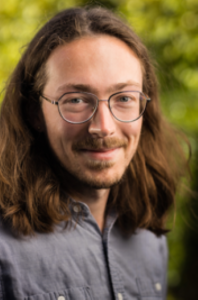Presented By: Department of Astronomy
The Department of Astronomy 2023-2024 Colloquium Series Presents:
Dr. Peter Senchyna, Postdoctoral Fellow, Carnegie Observatories

"Massive stars at cosmic dawn from the dark ages to our doorstep"
The first generations of massive stars fundamentally shaped the Universe we live in today, from forging metals released in the earliest large-scale enrichment events to generating and casting-out the ionizing photons necessary to drive the last great cosmic phase transition of reionization. Yet little is yet known for certain about these near-primordial young stellar populations, beyond a range of clues that suggest they were likely profoundly different from their well-studied counterparts in the Milky Way. At long last, JWST is now allowing us to directly view and begin to piece together the story of the first epochs of star formation and galaxy assembly. I will describe the surprising picture emerging from spectroscopy of these earliest glimpses of galaxies, including a high incidence of hard ionizing radiation fields and a complex interplay between rapidly-assembling massive black holes and dense highly-clustered star formation deep into the epoch of reionization. Much remains ambiguous in these early spectra, and I will discuss how detailed observations in the local Universe of metal-poor dwarf galaxies both resolved and unresolved are shedding key light on these high-redshift observations. Finally, I will outline how facilities coming online in the coming years will simultaneously revolutionize our view of both stellar populations at low metallicity and the first galaxies; from uncovering the most pristine relics of these earliest times on our cosmic doorstep to resolving galaxies at cosmic dawn into individual clusters and star forming regions.
The first generations of massive stars fundamentally shaped the Universe we live in today, from forging metals released in the earliest large-scale enrichment events to generating and casting-out the ionizing photons necessary to drive the last great cosmic phase transition of reionization. Yet little is yet known for certain about these near-primordial young stellar populations, beyond a range of clues that suggest they were likely profoundly different from their well-studied counterparts in the Milky Way. At long last, JWST is now allowing us to directly view and begin to piece together the story of the first epochs of star formation and galaxy assembly. I will describe the surprising picture emerging from spectroscopy of these earliest glimpses of galaxies, including a high incidence of hard ionizing radiation fields and a complex interplay between rapidly-assembling massive black holes and dense highly-clustered star formation deep into the epoch of reionization. Much remains ambiguous in these early spectra, and I will discuss how detailed observations in the local Universe of metal-poor dwarf galaxies both resolved and unresolved are shedding key light on these high-redshift observations. Finally, I will outline how facilities coming online in the coming years will simultaneously revolutionize our view of both stellar populations at low metallicity and the first galaxies; from uncovering the most pristine relics of these earliest times on our cosmic doorstep to resolving galaxies at cosmic dawn into individual clusters and star forming regions.